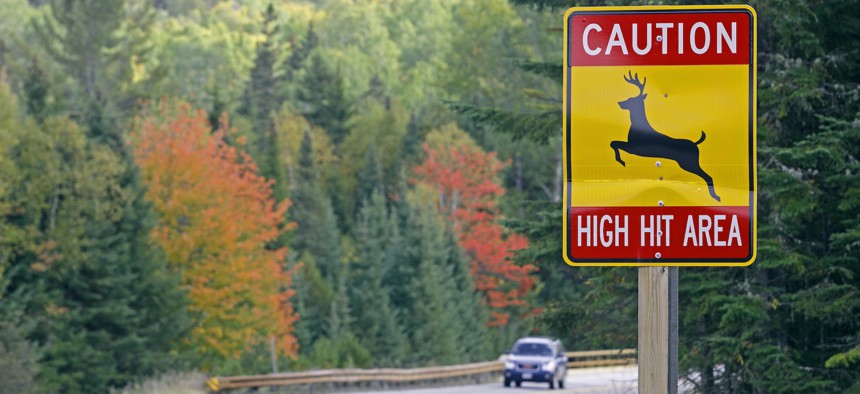What to Know About the $350M in New Funding for Wildlife Crossings

Fall foliage Route 16 deer crossing Franklin County, Maine. Education Images/Universal Images Group via Getty Images
The money to cut down on highway collisions between vehicles and animals was included in the infrastructure law. The application process for it should open early next year.
To prevent dangerous highway crashes and protect animals, Congress included hundreds of millions of dollars in the bipartisan infrastructure law for projects to help wildlife safely cross highways. The Federal Highway Administration expects to issue a notice of funding opportunity in early 2023 for the pilot program. But in the meantime, there are steps state and local officials can take to improve their chances of winning the new grant dollars, one expert tells Route Fifty.
Oh Deer, It’s a Big Problem
Each year on U.S. roadways, hundreds of thousands of animals are struck by cars. Insurer State Farm estimated earlier this year that drivers nationwide hit upwards of two million animals between July of 2020 and June of 2021. Between the 1970s and 2020, vehicle-animal collisions resulted in anywhere from around 80 to about 220 human fatalities annually, according to statistics compiled by the Insurance Institute for Highway Safety and Highway Loss Data Institute. The wrecks result in billions of dollars in property damages and other expenses, too.
Animal deaths, meanwhile, are often undercounted because people don’t always report when they’ve run over a small mammal or amphibian, notes Anna Wearn, director of government affairs for the Center for Large Landscape Conservation.
The Infrastructure Investment and Jobs Act includes $350 million to help improve options for animals to traverse busy roads. The money will be distributed over five years. This is the first time projects to reduce wildlife collisions and stitch together habitat cut apart by roads will have their own dedicated pot of funding, according to Wearn. It’s an important development, as wildlife crossing projects typically compete with other infrastructure priorities for money.
Under the new program, the Federal Highway Administration will be looking for projects that most effectively reduce motorist-wildlife collisions and that provide better “habitat connectivity,” according to an agency spokesperson.
While the grant application process isn’t open yet, there’s still plenty of work state and local agencies can get a head start on if they’re interested in the funding.
Gathering Information
Having data about collision rates in a particular area will, of course, help make the case for a wildlife crossing.
In determining whether a community would benefit from one, people will naturally look to roadways where there are high numbers of collisions. But there are other factors to consider.
Sometimes even a low collision count indicates an equally great need for a crossing. That’s because busy roads can have a “‘barrier effect” as animals recognize when it’s too dangerous to even attempt crossing, Wearn explained in a recent interview. When animals are unable to migrate to new areas, it can lead to inbreeding, difficulties finding food and other problems.
Beyond evaluating the need for a crossing, officials should also consider the practicality of the site they have in mind. It’s critical to ensure that there is wildlife habitat on either side of a proposed crossing. Understanding who owns the land, what their plans are, and how the landscape might change due to climate change are important considerations as well.
Data about collisions, migration habits and land use will inform not only decisions about whether a crossing is needed, but also what kind of crossing is most suitable.
Talk of the projects often conjures up images of hulking overpasses carpeted with greenery. But not all projects are that glamorous or at that scale, Wearn said. Sometimes upsizing culverts or installing directional fencing is enough to make a big difference.
Building Partnerships
Across the country, there are safe wildlife passage coalitions that often include entities like transportation and wildlife agencies, as well as natural resource departments, nonprofits, and universities.
“If those partnerships already exist, they probably have a lot of important data, they've probably started to come up with a process for identifying and prioritizing wildlife crossings, projects, or kind of general mitigation measures,” Wearn said.
These partnerships also help with community engagement and outreach, which will be part of the criteria for the pilot program, according to Wearn. While residents are often enthusiastic about wildlife crossings, local officials need to be aware of concerns, like whether a project could lead to more animals entering onto private property.
If a state or local government has trouble finding a coalition to work with, there’s no time like the present to build new relationships by organizing a wildlife and transportation summit or by encouraging state agencies to partner on initiatives, Wearn said.
Gaining Momentum
While the funding itself is significant, the wildlife crossing program carries added political and cultural significance, Wearn said. This is because it’s an issue that involves safety, conservation and economic concerns, and generally garners broad support from across the political spectrum—from conservative hunters to liberal animal rights activists.
Since the infrastructure law passed late last year, at least seven states—California, Colorado, Massachusetts, New Mexico, Oregon, Utah and Wyoming—have passed wildlife crossing legislation to set funds aside for matching grants, according to Wearn.
In Agoura Hills, California, construction of what’s been described as the world’s largest wildlife corridor recently began. The $100 million project, which will feature a bridge spanning 10 lanes of the 101 freeway, was largely funded by public-private partnerships.
“It's really exciting to work on an issue, in an era of a lot of partisanship and political divide and gridlock, that is so broadly supported,” Wearn said.
Molly Bolan is the assistant editor for Route Fifty.
NEXT STORY: County cleans up ‘a hot mess’ with cloud-based ERP and HR systems






